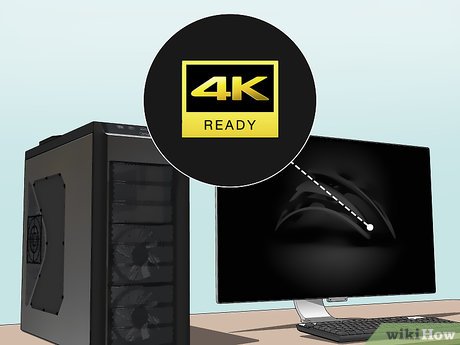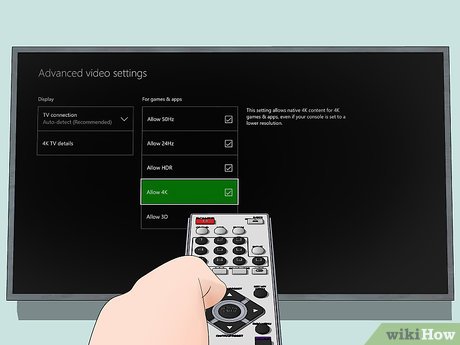How to Play 4k Video
This wikiHow teaches you how to play 4K resolution (2160p) videos on your computer or TV. Understand the limitations. Very few laptop computers have built-in screens which support 4K resolution, and the ones that do are prohibitively...
Method 1 of 3:
Playing 4K Video on Desktop
-
 How to Play 4k Video Picture 1 Understand the limitations. Very few laptop computers have built-in screens which support 4K resolution, and the ones that do are prohibitively expensive to purchase if you don't already have one. For the time being, 4K is predominately limited to desktop computers.
How to Play 4k Video Picture 1 Understand the limitations. Very few laptop computers have built-in screens which support 4K resolution, and the ones that do are prohibitively expensive to purchase if you don't already have one. For the time being, 4K is predominately limited to desktop computers.- Another limitation is your computer's power. 4K video requires a large processor, plentiful RAM, and a modern video card; you can't just attach a 4K monitor to your old PC and hope for the best.[1]
-
 How to Play 4k Video Picture 2 Make sure that you have a 4K monitor. 4K monitors come in several different shapes, sizes, and price ranges. Ideally, you'll find a monitor with a 60HZ refresh rate, but any 4K monitor in your price range will do.
How to Play 4k Video Picture 2 Make sure that you have a 4K monitor. 4K monitors come in several different shapes, sizes, and price ranges. Ideally, you'll find a monitor with a 60HZ refresh rate, but any 4K monitor in your price range will do.- Unlike the disparity between 1080p and 1080i monitors, all 4K monitors will show you the same resolution under the same circumstances.
-
 How to Play 4k Video Picture 3 Buy a 4K-ready HDMI cable. You most likely already have an HDMI cable in your home, and all HDMI cables technically support 4K video. However, the most recent version of the HDMI cable—HDMI 2.0, or "high-speed HDMI"—supports up to 60 frames per second of 4K, while traditional HDMI cables only support 30 frames per second.[2]
How to Play 4k Video Picture 3 Buy a 4K-ready HDMI cable. You most likely already have an HDMI cable in your home, and all HDMI cables technically support 4K video. However, the most recent version of the HDMI cable—HDMI 2.0, or "high-speed HDMI"—supports up to 60 frames per second of 4K, while traditional HDMI cables only support 30 frames per second.[2]- You can find HDMI 2.0 cables online for under $10 apiece, or you can find them in tech stores like Best Buy.
- If you use a DisplayPort connection instead, opt for a DisplayPort 1.4 cable. Its specifications are the same as HDMI 2.0.[3]
-
 How to Play 4k Video Picture 4 Use your 4K-ready cable to connect your monitor to your computer. Plug one end of the HDMI (or DisplayPort) cable into the back of your computer's tower, then plug the other end into one of your monitor's HDMI (or DisplayPort) ports.
How to Play 4k Video Picture 4 Use your 4K-ready cable to connect your monitor to your computer. Plug one end of the HDMI (or DisplayPort) cable into the back of your computer's tower, then plug the other end into one of your monitor's HDMI (or DisplayPort) ports. -
 How to Play 4k Video Picture 5 Go to your 4K video. If you have the file for the 4K video that you want to watch on your computer, find it. Otherwise, you'll have to download the file before proceeding.
How to Play 4k Video Picture 5 Go to your 4K video. If you have the file for the 4K video that you want to watch on your computer, find it. Otherwise, you'll have to download the file before proceeding. -
 How to Play 4k Video Picture 6 Open your video in a video player that supports 4K. This will allow you to watch the video right on your desktop:
How to Play 4k Video Picture 6 Open your video in a video player that supports 4K. This will allow you to watch the video right on your desktop:- Windows - You can use the Movies & TV app to watch 4K videos. Right-click your 4K video, select Open with, and click Movies & TV.[4]
- Mac - You can use QuickTime to play 4K videos. Click your 4K video, click File, select Open With, and click the QuickTime option.[5]
Method 2 of 3:
Playing 4K Video Online
-
 How to Play 4k Video Picture 7 Make sure that you meet the requirements. In order to enjoy 4K video, your monitor must support 4K resolution, and you must have your monitor connected to your computer via an HDMI or DisplayPort cable. Your computer must also be able to process 4K video, which may be difficult for laptop and low-end desktop computers.
How to Play 4k Video Picture 7 Make sure that you meet the requirements. In order to enjoy 4K video, your monitor must support 4K resolution, and you must have your monitor connected to your computer via an HDMI or DisplayPort cable. Your computer must also be able to process 4K video, which may be difficult for laptop and low-end desktop computers.- If you want to watch your 4K video in 60 frames per second, make sure that you have an HDMI 2.0 or DisplayPort 1.4 cable.
-
 How to Play 4k Video Picture 8 Consider connecting your computer to your router. Using an Ethernet cable to transfer your Internet connection directly into your computer rather than using Wi-Fi will ensure the smoothest possible streaming.
How to Play 4k Video Picture 8 Consider connecting your computer to your router. Using an Ethernet cable to transfer your Internet connection directly into your computer rather than using Wi-Fi will ensure the smoothest possible streaming. -
 How to Play 4k Video Picture 9 Close any large background programs or processes. Having extra programs, browsers, or processes (e.g., downloads or updates) running while attempting to watch 4K video in your browser will most likely cause the video to lag.
How to Play 4k Video Picture 9 Close any large background programs or processes. Having extra programs, browsers, or processes (e.g., downloads or updates) running while attempting to watch 4K video in your browser will most likely cause the video to lag. -
 How to Play 4k Video Picture 10 Find and open a video that supports 4K. Many shows and movies on Netflix support 4K, and you'll find a significant amount of 4K content on YouTube and Vimeo.
How to Play 4k Video Picture 10 Find and open a video that supports 4K. Many shows and movies on Netflix support 4K, and you'll find a significant amount of 4K content on YouTube and Vimeo. -
 How to Play 4k Video Picture 11 Select 4K quality. This will vary depending on your service, but you'll usually click a gear-shaped iconor click the current quality (e.g., 1080p) and then click the 4K or 2160p option.
How to Play 4k Video Picture 11 Select 4K quality. This will vary depending on your service, but you'll usually click a gear-shaped iconor click the current quality (e.g., 1080p) and then click the 4K or 2160p option. How to Play 4k Video Picture 12
How to Play 4k Video Picture 12 -
 How to Play 4k Video Picture 13 Enjoy your 4K content. As long as you meet the hardware and software requirements to watch 4K video, you should be able to watch 4K video inside of your computer's browser whenever you like.
How to Play 4k Video Picture 13 Enjoy your 4K content. As long as you meet the hardware and software requirements to watch 4K video, you should be able to watch 4K video inside of your computer's browser whenever you like.
Method 3 of 3:
Playing 4K Video on a TV
-
 How to Play 4k Video Picture 14 Make sure that your TV supports 4K. You can't watch 4K video on a TV with a resolution under 4K (2160p).
How to Play 4k Video Picture 14 Make sure that your TV supports 4K. You can't watch 4K video on a TV with a resolution under 4K (2160p).- If you don't have a 4K TV, you can purchase one at any tech store or online.
-
 How to Play 4k Video Picture 15 Buy a 4K-ready source. Plenty of modern video input sources, such as modern Blu-Ray players and the PlayStation 4 Pro/Xbox One X, support 4K DVDs at a 60 frames per second rate. If you don't have a source which supports 4K, you can buy one online or in any tech store.
How to Play 4k Video Picture 15 Buy a 4K-ready source. Plenty of modern video input sources, such as modern Blu-Ray players and the PlayStation 4 Pro/Xbox One X, support 4K DVDs at a 60 frames per second rate. If you don't have a source which supports 4K, you can buy one online or in any tech store.- If you want to stream 4K video from a service such as Netflix or Hulu, your source doesn't have to support 4K.
-
 How to Play 4k Video Picture 16 Consider streaming 4K video. You can stream 4K video using anything from your computer to a gaming console. Many services like Netflix support 4K video for some of their content, so this is a good option if you don't want to shell out for a 4K DVD.
How to Play 4k Video Picture 16 Consider streaming 4K video. You can stream 4K video using anything from your computer to a gaming console. Many services like Netflix support 4K video for some of their content, so this is a good option if you don't want to shell out for a 4K DVD.- If you're streaming 4K video, connecting your source to your router is a good way to ensure that you have consistent streaming speeds.
-
 How to Play 4k Video Picture 17 Buy a 4K-ready HDMI cable. You most likely already have an HDMI cable in your home, and all HDMI cables technically support 4K video. However, the most recent version of the HDMI cable—HDMI 2.0, or "high-speed HDMI"—supports up to 60 frames per second of 4K, while traditional HDMI cables only support 30 frames per second.[6]
How to Play 4k Video Picture 17 Buy a 4K-ready HDMI cable. You most likely already have an HDMI cable in your home, and all HDMI cables technically support 4K video. However, the most recent version of the HDMI cable—HDMI 2.0, or "high-speed HDMI"—supports up to 60 frames per second of 4K, while traditional HDMI cables only support 30 frames per second.[6]- You can find HDMI 2.0 cables online for under $10 apiece, or you can find them in tech stores like Best Buy.
- If you use a DisplayPort connection instead, opt for a DisplayPort 1.4 cable. Its specifications are the same as HDMI 2.0.[7]
-
 How to Play 4k Video Picture 18 Use your 4K-ready cable to connect your TV to the source. Plug one end of the HDMI (or DisplayPort) cable into the back of your video source, then plug the other end into one of your TV's HDMI (or DisplayPort) ports.
How to Play 4k Video Picture 18 Use your 4K-ready cable to connect your TV to the source. Plug one end of the HDMI (or DisplayPort) cable into the back of your video source, then plug the other end into one of your TV's HDMI (or DisplayPort) ports. -
 How to Play 4k Video Picture 19 Sit close to the TV. Unlike traditional HD TVs, 4K is incredibly dense, meaning that you'll achieve the greatest visual quality when sitting closer than you would if you were watching your video on a 1080p (or lower) resolution TV.[8]
How to Play 4k Video Picture 19 Sit close to the TV. Unlike traditional HD TVs, 4K is incredibly dense, meaning that you'll achieve the greatest visual quality when sitting closer than you would if you were watching your video on a 1080p (or lower) resolution TV.[8] -
 How to Play 4k Video Picture 20 Watch 4K content. The content that you watch will depend on your selected method of viewing, but you should be able to see most 4K content as such on your TV via your source.
How to Play 4k Video Picture 20 Watch 4K content. The content that you watch will depend on your selected method of viewing, but you should be able to see most 4K content as such on your TV via your source. -
 How to Play 4k Video Picture 21 Adjust your TV's or source's settings if necessary. In some cases, you may have to raise your TV's (or source's) maximum default quality from 1080p to 4K (or 2160p). You can usually do this in the Settings section; if you can't find the proper settings to change, consult your TV's or source's manual.
How to Play 4k Video Picture 21 Adjust your TV's or source's settings if necessary. In some cases, you may have to raise your TV's (or source's) maximum default quality from 1080p to 4K (or 2160p). You can usually do this in the Settings section; if you can't find the proper settings to change, consult your TV's or source's manual.
4.5 ★ | 2 Vote
You should read it
- Best HDMI cable for monitors, LG TVs, Samsung and Apple TVs
- How many types of HDMI cables are there? HDMI cable classification
- Does gold-plated HDMI cable make better image quality?
- What is an HDMI cable? How many types of HDMI cables are there? The similarities and differences between them
- How to Buy HDMI Cables
- Learn about HDMI and HDMI switch
- What is HDMI? What is HDMI used for?
- Difference between HDMI and DVI
- The 5 best HDMI splitters of 2023
- How to Connect Computer to TV
- All things need to know about HDMI 2.1 standard
- How to Connect HDMI to TV

























 This hidden setting in Windows will make videos play smoother!
This hidden setting in Windows will make videos play smoother! How to turn on and off the auto play feature on Zalo
How to turn on and off the auto play feature on Zalo YouTube tests 'crazy' 4x video playback speed
YouTube tests 'crazy' 4x video playback speed How to turn off auto-play videos on Viber
How to turn off auto-play videos on Viber How to play a video format that is not supported on Windows 10
How to play a video format that is not supported on Windows 10 How to Play Video Games
How to Play Video Games